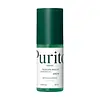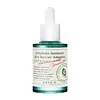What's inside
What's inside
 Key Ingredients
Key Ingredients

 Benefits
Benefits

 Concerns
Concerns

No concerns
 Ingredients Side-by-side
Ingredients Side-by-side

Water
Skin ConditioningGlycerin
HumectantDipropylene Glycol
HumectantPropanediol
SolventCentella Asiatica Extract
CleansingButylene Glycol
HumectantNiacinamide
Smoothing1,2-Hexanediol
Skin ConditioningSodium Hyaluronate
HumectantPanthenol
Skin ConditioningMadecassoside
AntioxidantAsiaticoside
AntioxidantMadecassic Acid
Skin ConditioningAsiatic Acid
Skin ConditioningCentella Asiatica Callus Extracellular Vesicles
Allantoin
Skin ConditioningPalmitoyl Tetrapeptide-7
Skin ConditioningPalmitoyl Hexapeptide-12
Skin ConditioningPalmitoyl Tripeptide-1
Skin ConditioningPalmitoyl Dipeptide-10
Skin ConditioningPolyglyceryl-10 Laurate
Skin ConditioningCarbomer
Emulsion StabilisingPolyglyceryl-10 Myristate
Skin ConditioningHydrolyzed Jojoba Esters
Skin ConditioningTromethamine
BufferingEthylhexylglycerin
Skin ConditioningXanthan Gum
EmulsifyingDipotassium Glycyrrhizate
HumectantAdenosine
Skin ConditioningDisodium EDTA
Sucrose Stearate
EmollientGlyceryl Stearate
EmollientHydrogenated Lecithin
EmulsifyingPolyglyceryl-10 Stearate
Skin ConditioningCeramide NP
Skin ConditioningCamellia Sinensis Leaf Extract
AntimicrobialPancratium Maritimum Extract
BleachingCitrus Aurantium Bergamia Fruit Oil
MaskingPinus Sylvestris Leaf Oil
MaskingRosmarinus Officinalis Leaf Oil
MaskingLavandula Hybrida Oil
EmollientLimonene
PerfumingLinalool
PerfumingWater, Glycerin, Dipropylene Glycol, Propanediol, Centella Asiatica Extract, Butylene Glycol, Niacinamide, 1,2-Hexanediol, Sodium Hyaluronate, Panthenol, Madecassoside, Asiaticoside, Madecassic Acid, Asiatic Acid, Centella Asiatica Callus Extracellular Vesicles, Allantoin, Palmitoyl Tetrapeptide-7, Palmitoyl Hexapeptide-12, Palmitoyl Tripeptide-1, Palmitoyl Dipeptide-10, Polyglyceryl-10 Laurate, Carbomer, Polyglyceryl-10 Myristate, Hydrolyzed Jojoba Esters, Tromethamine, Ethylhexylglycerin, Xanthan Gum, Dipotassium Glycyrrhizate, Adenosine, Disodium EDTA, Sucrose Stearate, Glyceryl Stearate, Hydrogenated Lecithin, Polyglyceryl-10 Stearate, Ceramide NP, Camellia Sinensis Leaf Extract, Pancratium Maritimum Extract, Citrus Aurantium Bergamia Fruit Oil, Pinus Sylvestris Leaf Oil, Rosmarinus Officinalis Leaf Oil, Lavandula Hybrida Oil, Limonene, Linalool
Water
Skin ConditioningAloe Barbadensis Leaf Water
MaskingButylene Glycol
HumectantSodium Hyaluronate
HumectantCentella Asiatica Extract
CleansingGlycerin
HumectantBetaine
HumectantPropanediol
SolventGlycyrrhiza Uralensis Root Extract
Skin ConditioningHieracium Umbellatum Extract
Skin ConditioningCynara Scolymus Leaf Extract
Skin ConditioningSorbitol
HumectantAloe Barbadensis Leaf Extract
EmollientDioscorea Japonica Root Extract
Skin ConditioningLaminaria Japonica Extract
Skin Protecting1,2-Hexanediol
Skin ConditioningXanthan Gum
EmulsifyingCarbomer
Emulsion StabilisingLinum Usitatissimum Seed Extract
PerfumingHibiscus Esculentus Fruit Extract
Skin ConditioningAloe Barbadensis Leaf Juice
Skin ConditioningArctium Lappa Root Extract
Skin ConditioningHibiscus Mutabilis Flower Extract
Skin ConditioningCorchorus Olitorius Leaf Extract
Skin ConditioningRheum Palmatum Root Extract
AstringentAlthaea Rosea Flower Extract
Skin ConditioningDimethyl Sulfone
SolventChlorphenesin
AntimicrobialEthylhexylglycerin
Skin ConditioningPolyglutamic Acid
Skin ConditioningBeta-Glucan
Skin ConditioningArginine
MaskingAllantoin
Skin ConditioningAdenosine
Skin ConditioningWater, Aloe Barbadensis Leaf Water, Butylene Glycol, Sodium Hyaluronate, Centella Asiatica Extract, Glycerin, Betaine, Propanediol, Glycyrrhiza Uralensis Root Extract, Hieracium Umbellatum Extract, Cynara Scolymus Leaf Extract, Sorbitol, Aloe Barbadensis Leaf Extract, Dioscorea Japonica Root Extract, Laminaria Japonica Extract, 1,2-Hexanediol, Xanthan Gum, Carbomer, Linum Usitatissimum Seed Extract, Hibiscus Esculentus Fruit Extract, Aloe Barbadensis Leaf Juice, Arctium Lappa Root Extract, Hibiscus Mutabilis Flower Extract, Corchorus Olitorius Leaf Extract, Rheum Palmatum Root Extract, Althaea Rosea Flower Extract, Dimethyl Sulfone, Chlorphenesin, Ethylhexylglycerin, Polyglutamic Acid, Beta-Glucan, Arginine, Allantoin, Adenosine
 Reviews
Reviews

Ingredients Explained
These ingredients are found in both products.
Ingredients higher up in an ingredient list are typically present in a larger amount.
1,2-Hexanediol is a synthetic liquid and another multi-functional powerhouse.
It is a:
- Humectant, drawing moisture into the skin
- Emollient, helping to soften skin
- Solvent, dispersing and stabilizing formulas
- Preservative booster, enhancing the antimicrobial activity of other preservatives
Adenosine is in every living organism. It is one of four components in nucleic acids that helps store our DNA.
Adenosine has many benefits when used. These benefits include hydrating the skin, smoothing skin, and reducing wrinkles. Once applied, adenosine increases collagen production. It also helps with improving firmness and tissue repair.
Studies have found adenosine may also help with wound healing.
In skincare products, Adenosine is usually derived from yeast.
Learn more about AdenosineAllantoin is a soothing ingredient known for its protective and moisturizingg properties. Because of this, it is often added to products with strong active ingredients.
Studies show higher concentrations of this ingredient can promote wound healing.
Though it can be derived from the comfrey plant, allantoin is produced synthetically for cosmetic products to ensure purity.
Learn more about AllantoinButylene Glycol (or BG) is used within cosmetic products for a few different reasons:
Overall, Butylene Glycol is a safe and well-rounded ingredient that works well with other ingredients.
Though this ingredient works well with most skin types, some people with sensitive skin may experience a reaction such as allergic rashes, closed comedones, or itchiness.
Learn more about Butylene GlycolCarbomer is a polymer of acrylic acid. Its main role is to create a gel consistency.
A high amount of carbomer can cause pilling or balling up of products. Don't worry, most products contain 1% or less of carbomer.
Centella Asiatica Extract (Centella) is derived from an herb native to Southeast Asia. It is famous for its anti-inflammatory and soothing properties.
Centella is rich in antioxidants and amino acids, such as Madecassic Acid and Asiaticoside.
Studies show the compounds in centella help with:
The combination of all these properties makes centella effective at soothing, hydrating, and protecting the skin.
Other great components of centella include Vitamin A, vitamin C, several B vitamins, and Asiatic Acid.
Fun fact: Centella has been used as a medicine and in food for many centuries. As a medicine, it is used to treat burns, scratches, and wounds.
Learn more about Centella Asiatica ExtractEthylhexylglycerin (we can't pronounce this either) is commonly used as a preservative and skin softener. It is derived from glyceryl.
You might see Ethylhexylglycerin often paired with other preservatives such as phenoxyethanol. Ethylhexylglycerin has been found to increase the effectiveness of these other preservatives.
Glycerin is already naturally found in your skin. It helps moisturize and protect your skin.
A study from 2016 found glycerin to be more effective as a humectant than AHAs and hyaluronic acid.
As a humectant, it helps the skin stay hydrated by pulling moisture to your skin. The low molecular weight of glycerin allows it to pull moisture into the deeper layers of your skin.
Hydrated skin improves your skin barrier; Your skin barrier helps protect against irritants and bacteria.
Glycerin has also been found to have antimicrobial and antiviral properties. Due to these properties, glycerin is often used in wound and burn treatments.
In cosmetics, glycerin is usually derived from plants such as soybean or palm. However, it can also be sourced from animals, such as tallow or animal fat.
This ingredient is organic, colorless, odorless, and non-toxic.
Glycerin is the name for this ingredient in American English. British English uses Glycerol/Glycerine.
Learn more about GlycerinPropanediol is an all-star ingredient. It softens, hydrates, and smooths the skin.
It’s often used to:
Propanediol is not likely to cause sensitivity and considered safe to use. It is derived from corn or petroleum with a clear color and no scent.
Learn more about PropanediolSodium Hyaluronate is hyaluronic acid's salt form. It is commonly derived from the sodium salt of hyaluronic acid.
Like hyaluronic acid, it is great at holding water and acts as a humectant. This makes it a great skin hydrating ingredient.
Sodium Hyaluronate is naturally occurring in our bodies and is mostly found in eye fluid and joints.
These are some other common types of Hyaluronic Acid:
Learn more about Sodium HyaluronateWater. It's the most common cosmetic ingredient of all. You'll usually see it at the top of ingredient lists, meaning that it makes up the largest part of the product.
So why is it so popular? Water most often acts as a solvent - this means that it helps dissolve other ingredients into the formulation.
You'll also recognize water as that liquid we all need to stay alive. If you see this, drink a glass of water. Stay hydrated!
Learn more about WaterXanthan gum is used as a stabilizer and thickener within cosmetic products. It helps give products a sticky, thick feeling - preventing them from being too runny.
On the technical side of things, xanthan gum is a polysaccharide - a combination consisting of multiple sugar molecules bonded together.
Xanthan gum is a pretty common and great ingredient. It is a natural, non-toxic, non-irritating ingredient that is also commonly used in food products.
Learn more about Xanthan Gum